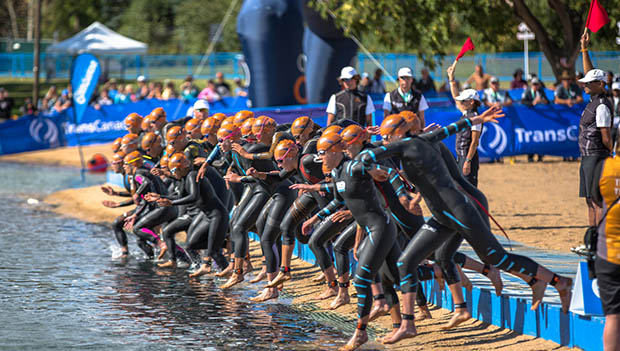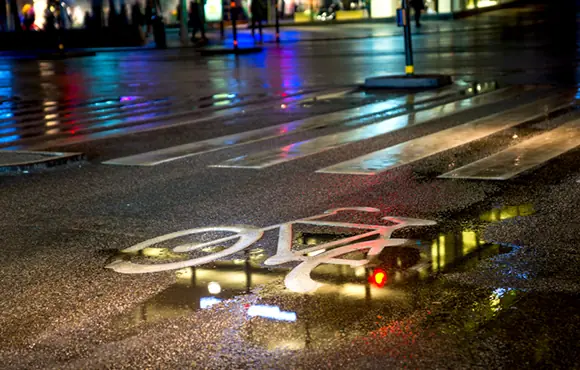
Want to race like Mirinda Carfrae, the Brownlee brothers or Gwen Jorgensen? Try these pro-tested tips, and you'll be on your way to swimming, biking and running your way to the very top of the podium.
High Intensity Year-Round
Don't skip the VO2 intervals or work at your current functional threshold power level. These training modes are the most efficient at keeping you fit, and come race season you won't have to completely rebuild these systems. If you're a trained athlete with a good fitness foundation, intensity may be more important than volume for making gains and improving fitness.
Train Fast to Race Fast
Pros complete high intensity intervals to practice race efforts and train their bodies to respond positively to going hard. You can practice going hard on the swim, bike and run, but you'll need to experiment with balancing your training--if you don't have a triathlon coach to do this for you. This may mean you don't get that hard effort in on each sport in every session but rather spread the work across your training calendar.Weight Training
Finding time to balance training three sports can be hard, so adding yet another element to your already-packed schedule may seem overwhelming. However, it is important to focus not only on cardio but also on strength and flexibility.
Even if it is just one day a week, you should find time in your week to add some weight training. This will allow you to strengthen muscles that work in opposition to the muscle groups you recruit in triathlon, thus keeping your body balanced. A weekly weight session also affords an opportunity to strengthen your core muscles--which will improve your form across all three disciplines and also helps prevent injuries.
Train the Swim
Unless you come from a swimming background, you may not be swimming enough to be proficient or comfortable enough in a triathlon. Even the fastest-swimming pros train the swim enough to use it to their advantage. Swim training should include a mix of distances and efforts, with some drills to improve technique--not just swimming endless laps. Some triathletes find it easiest to join a masters swim team. And, if you have a chance to practice safely in open water, go for it.Roll With It
No matter how much preparation you put into training, any number of things can happen--you don't feel on your game, you get a flat, you feel a blister forming on the run. The best think you can do is stay calm. Races are long, and there's plenty of time to make up for small time losses.Pace for Effectiveness and Enjoyment
Pros race successfully through practicing effective pacing and enjoying what they do. Different race distances require different effort intensities, so when you race, be aware of what effort is right for you and the distance you're trying to complete. For long-course races, start out easy, then aim to negative split (go faster as you progress). While you may feel amazing at the start, think about how you'll be feeling two, four or even 10 hours later.Train With a Partner
Many of the pros have training partners or train with a group. This keeps them motivated and focused. A training partner or group can be what gets you out of bed in the morning when you just don't want to get up, or that moral support when the workout starts to feel really tough.
Training partners also make the training more fun. Making the training part of your social life can give it a double benefit and help you stay more fit and focused year in and year out.
Focus on Your Race
Everyone has different weaknesses and strengths in triathlon --even the pros. The key to racing your best is to understand your own abilities and to stay focused on your own race. It can be really motivating to pass someone on the swim, bike or run, but if you are way over your pace to do so, you will likely blow up and may not even be able to finish. Remember: It is you against yourself, so do what you need to make your experience as fun as possible.Slide on in
On race morning when nerves may be high, getting into a wetsuit can feel like an impossibly frustrating task. With all that energy on race morning, you may accidentally tear your wetsuit trying to pull it on--a terrible way to start a race. Put a plastic bag on your feet and hands to help them easily slide into the leg or sleeve of a wetsuit, and take care if you haven't recently trimmed your nails.Gliding Over It
Plastic bags can help you slide hands and feet thru your wetsuit, but well-placed anti-chafe lubes can help you get it off in a hurry--as well as prevent chafing that will nag you for the rest of the race and even days later. Consider using your favorite anti-chafe lube around your neck to prevent chafing around the areas where your tri pad will hit on your legs while swimming. Pros will often even put it around the bottom of their legs where the wetsuit ends to help the wetsuit easily and quickly slide off.Mental Map
While it is easy to get focused on the core parts of the race--swimming, biking and running--it is also important to have your spot in transition fully mapped out. Pay attention to where the entry and exit points are for each leg. Note landmarks and other visual cues to help you quickly find your bike after the swim, and know where to return it after the run.Spare Nothing
While it is not possible to bring a spare everything (like a spare tri bike ), you can bring extras of many small items. Make sure your tri bag is packed with spare goggles, spare elastic shoe laces, a spare race belt, spare sunglasses, extra nutrition and even an extra tri suit. These are small items that may easily fail, so coming prepared means you'll be able to stay calm instead of spending your time before the race running around asking others to borrow their spares.Get in Gear
Pros can immediately start pedaling without shifting and get up to speed as they exit transition on their bike. Make sure to leave your bike in the gear you'll want before racking it. Typically, this gear will be easy enough to get going quickly once you mount up.
Band It
>Pros keep their shoes clipped into their bike pedals, using rubber bands secured to their bike frame. This keeps their shoes upright, so they can immediately start pedaling when they exit transition. This is an advanced skill; getting into your shoes while already on the bike takes concentration and practice, so don't try it for the first time during a race.Maintain Your Equipment
Nothing is worse than packing for a race and realizing some key piece of equipment isn't race-ready. You spent all the time preparing your body for the race, make sure you give the same attention to your equipment. Make sure your goggle straps aren't about to break. Get a bike tune-up well before the big day. Don't break out a new pair of running shoes on race day, as they may not be properly broken in and lead to lots of blisters.Run Away!
Elastic shoelaces are the perfect accessory for your race-day running shoes. These stretchy laces allow you to quickly slip on your shoes without having to stop to tie them. Plus, you can set the tension in advance, so you don't have one shoe feeling tighter than the other. An added bonus: You won't have to worry about your shoes ever coming untied while racing.
What pros do: Put some talc in your cycling and running shoes. This helps your feet slide right in and also prevents chafing on the ride and the run. If you do this, you'll want to put just enough powder into your shoes for your feet to slide in but not so much that it cakes to your feet and looks like clouds coming out of your shoes when you zoom away.
Fuel Your Passion
You've done the training and you have your equipment ready to go, but don't forget to focus on your fuel. For long races, nutrition can make the difference between finishing or not. But even for short races, nutrition is important. Make sure you have something to drink on the bike--at the very least you'll probably want to rinse out your mouth after the swim. Before race day, figure out what gels, bars and other snacks you can eat quickly and that won't upset your stomach. The longer your race, the more nutrition you'll need. Also, don't forget to eat them while you're racing. It is easy to forget to eat when you are feeling good and focused on speed, but this could come back to haunt you later in the race.
READ THIS NEXT: 14 Things Pro Cyclists Do to Get Faster on the Bike








Discuss This Article